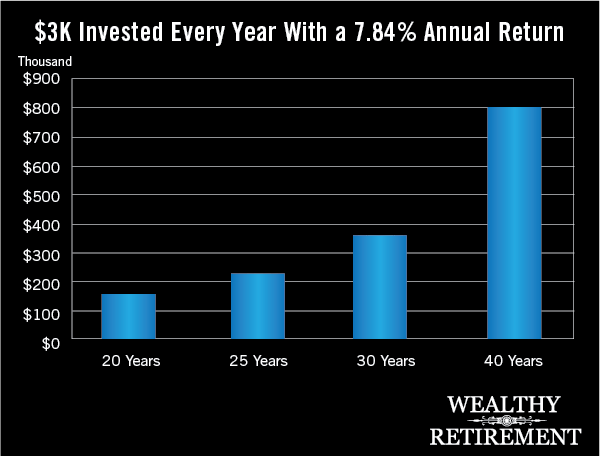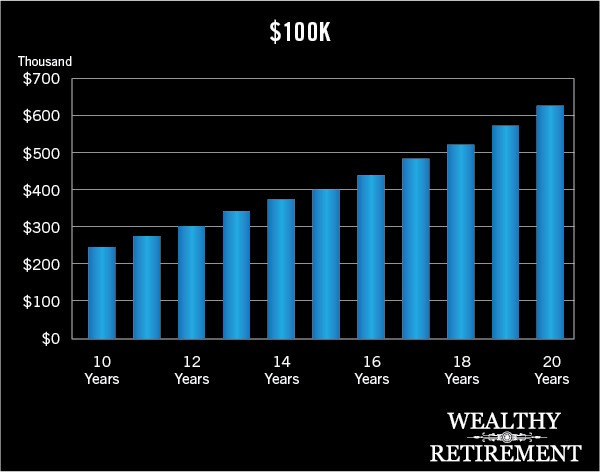 “Time is on my side, yes it is.”- Rolling Stones
“Time is on my side, yes it is.”- Rolling Stones
Most investors spend a lot of time and effort picking the right stock, fund or investment manager. But they’re focusing on the wrong thing.
Instead, investors need to focus their energies on getting as much money into the market as early as possible.
For long-term investors, time is the most important element of investing success. Sure, picking some big winners and avoiding losers will help, but the longer investors have to allow their money to compound, the more cash they will end up with.
And each extra year that the money can be left alone to compound pays off in a very big way.
[ad#Google Adsense 336×280-IA]Consider:
If an investor invests $3,000 in the market each year for 40 years and achieves just a 6% annual return (nearly two percentage points below the historical average), the investor will wind up with $492,143.
That same investor who invests for only 30 years would need to achieve a 9.5% annual return, a point and a half above the historical market average and over 50% higher than the 40-year investor.
Cut the time down to 25 years, and the investor needs to earn about 12.5% per year, over 50% more than the market average: a very difficult task.
And if the investor has only 20 years in the market, she’ll need to earn 17.5% per year, more than double the market’s historical average: nearly impossible.
Let’s look at it another way. An investor puts $3,000 per year to work in the market and earns the S&P’s 50-year historical average of 7.84% (not including dividends).
The investor who saves $3,000 a year for 40 years and makes an average annual return of 7.84% will have $803,583. The 30-year investor has less than half that amount at $355,909.
Look at the difference those last 10 years made. That’s the power of compounding. If you can keep the money invested just 10 years longer, you make an additional $417,000.
If you’re investing for 25 years, you wind up with $231,056 and, in 20 years, you finish with $145,451. Granted, if you’re saving for 40 years instead of 20, you’re contributing an extra $60,000, but the difference in the final amount is over 10 times that $60,000 investment.

Now, I realize not everyone has 40 years to invest. But let’s take a look at the difference a few years can make.
A Big Difference
Let’s assume you have a starting capital of $100,000 invested in the S&P 500, and the market increases at its historical average of 7.84%.
Let’s also assume that dividends, from where they are today at a historically low 2%, increase by the historical average growth rate of 5.5% per year and are reinvested. No other funds are invested after the initial $100,000.

It’s interesting to note how much more money you get each year the further out you go.
In year 11, your account rises by about $24,000. In year 15, the increase is about $34,000. In year 19, you’re making another $48,500 a year and, if you wait just one more year, in year 20, the growth is nearly $53,000.
That’s how compounding works. You make money on your original investment, plus the money you already made, multiplying it many times over. So even holding on for one year can make a substantial difference.
Imagine the above scenario is your nest egg. After 19 years, you have $570,828. If you could delay tapping into it for just 12 more months, you’d have $623,587. That extra $52,759 could be the difference between taking a nice vacation and sitting at home, paying the medical bills or warding off bill collectors.
Keep your money invested for as long as possible. And if you know someone with a long time horizon, share this article with them. A lot of young people think that because they have so many years before they retire, they have plenty of time to start saving and investing. But every dollar they invest today can multiply many times in the future.
As I’ve shown you, every year you’re invested can make a big difference.
Oh, and that $100,000 invested over 30 years turns into $1.5 million.
— Marc Lichtenfeld
[ad#sa-generic]
Source: Wealthy Retirement
